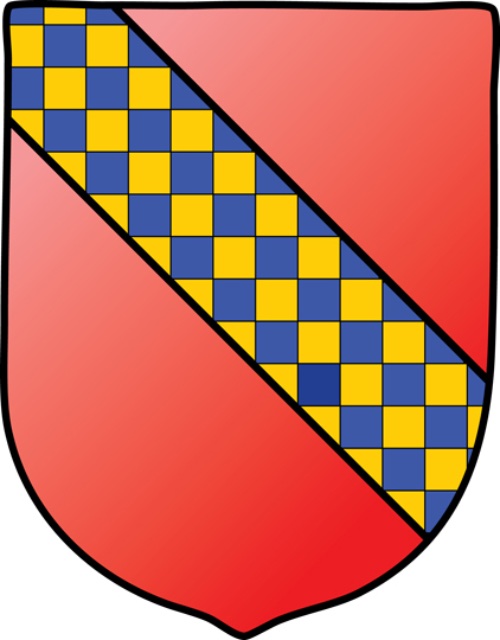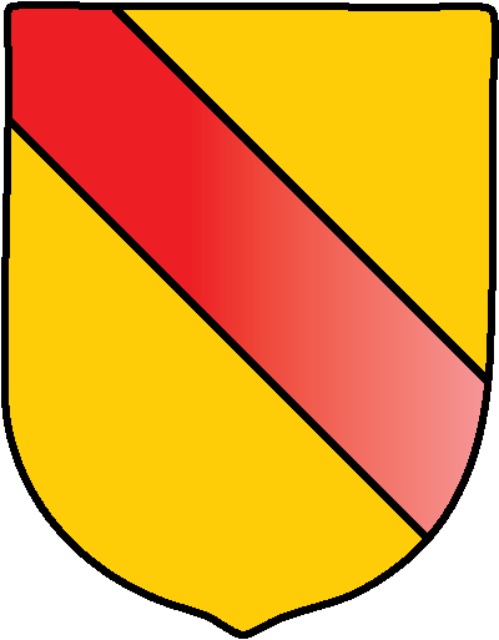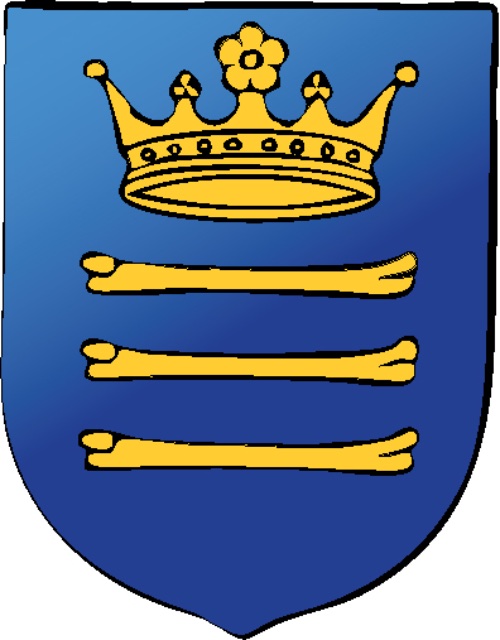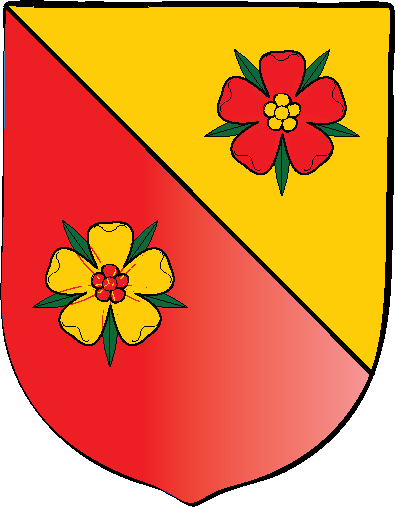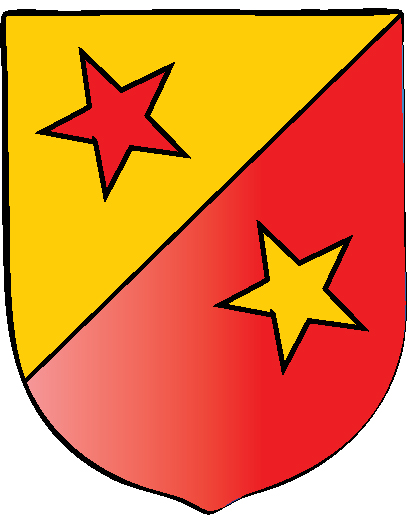The Baseggio Coats of Arms
Currently we distinguish eight different Coats of Arms, three of them being variations of the Golden Bones design. This leaves us with the following six main designs:






In addition we use a logo type coat of arms when it comes to illustrating activities related to the genealogical project baseggio.net (social media avatars, event invitations, etc.) Find the detailed information about our Internet Coat of Arms in the dedicated article.Krankzüchtungen
Arma Triestina/Brasão Brasileiro (Brazilian Coat of Arms)
Gules, a bend chequy azure and or.
Sauro de Baseggio (BNID0079) provided the following information: "Stemma del ramo Triestino facente parte delle Tredici Casate. Conservato nell'atrio del Castello di S. Giusto [a Trieste]." (The source of this information is unknown.)
Consequently the family originally carrying this coat of arms is extinct.
Nowadays it is used by our Brazilian branches.
Red Ribbon
Or, a bend gules.
This used to be the old Coat of Arms of the Baseggios from Venice, based on the information found in "Famiglie venete con le loro armi" (alfa.o.3.2/5), two 17th cent. manuscripts. (Provided by Biblioteca estense universitaria, Modena, Italy, http://bibliotecaestense.beniculturali.it.)
In 1204 AD this design was replaced by the Golden Bones Coat of Arms. (See below.)Golden Bones
Azure, in chief the crown of the Latin Empire of Constantinople, in base three bones in pale or.
In 1204 AD the Venetian Baseggio Family was awarded a new coat of arms by the Latin Emperor Baldwin I of Constantinople (the former Count of Flanders). During the 4th Crusade Giovanni Basegio fought as captain of a galley and it seems he did it fairly well. During the coronation ceremony of Baldwin I of Constantinople, he was awarded a new coat of arms, carrying three golden bones and the Latin Emperor's crown.
This coat of arms replaced the former one in 1204 AD and is in use by Giovanni's descendants to the present day.
The following text is an excerpt of Paolo Rannusios book "Della Guerra di Costantinopoli" ("About the Constantinople War"); published by Domenico Nicolini, Venice, 1604.
The scan can be found at Google Books.

"[The Latin Emperor Baldwin of Flanders] gave many imperial honours and military decorations to the Venetian noblemen. and in particular he awarded knighthood to the famous captain of a galley Giovanni Basegio for his virtue, and also allow him to carry the Imperial Crown on a blue shield, to show how much he felt in favour of the Venetians, sharing the symbol of his empire in this coat of arms, which was adopted by the Basegio Family, replacing the former."
The same is mentioned in Johann Friedrich Le Bret's "Staatsgeschichte der Republik Venedig" (Stuttgart, 1768): "One of his counselors, Johannes Basegio, who had particularly distinguished himself among the army and had stood in the closest association with Balduin, he knighted and granted him the right to bear the imperial crown in the blue field on his coat of arms.”
The Three Ravens
An interesting evolution of the Golden Bones coat of arms takes place in mid 17th century, driven by the Baselli branch of the family. The Baselli appear in documents from the second half of the 16th century in the vicinity of Gradisca d’Isonzo and Gorizia (present-day Italy).
Ireneo della Croce suggests that the Baselli descend from the Triestine Baseggio, which seems rather implausible. We think that the Baselli are a branch of the Baseggio from Capodistria. The most important evidence for this is indeed the fact that they use of a variant of the Golden Bones coat of arms from 1204. It's very unlikely that a family would be allowed to take over the design of another in the late 16th or early 17th century, without being strongly related. When families branched out and were geographically separated, it was common to alter details in the family crest. Different color schemes, adding or removing individual components were used to distinguish between branches while still signaling a sense of unity.Della Croce attempts to argue away the connection between the Baselli family and the Venetian Baseggio, likely because he himself is strongly interested in presenting noble families with a spirit committed to the Austro-Hungarian crown. His work “Historia antica e moderna, sacra e profana della citta de Trieste” repeatedly emphasizes that it is the destiny of the city of Trieste to flourish under “the wings of the Austrian eagle.” Therefore, he understood the Baselli’s origin to be more aligned with the Triestine Baseggio lineage, suggesting that they had left Trieste in the distant past and their use of a variation of the Venetian Baseggios' coat of arms was just coincidental.
We have a completely different opinion here: The Baselli descend from the same lineage as the Baseggio, who found their way from Venice to Capodistria before 1550. A family or business connection led to a branch of the family settling in the vicinity of Gradisca d’Isonzo in the second half of the 16th century. Loyalty to the local princes in 1647 resulted in the family coat of arms being expanded to include ravens and an additional crown.
But these representations are entirely based on assumptions; the current data does not allow for a definitive statement about the exact relationships between the families from Venice, Capodistria, Trieste, and Gradisca. It’s also important to consider that these localities are all within a radius of less than 60 km. This means that there may have been multiple movements, which are nearly impossible to trace back today.
The drawings below were taken from the "Historia antica e moderna, sacra e profana della citta de Trieste" by Father Ireneo Della Croce, 1698.
Two Ravens
Three Ravens
The elaborate display of privileges, symbolized by the three ravens and the crown added to the Venetian coat of arms used by the Gradisca Baselli, was granted to them by a special diploma in 1647 by the Serene Prince Giovanni Antonio d’Egenberg, Duke of Cromau. This recognition was based on their service and merits in the fields of war and unwavering loyalty to the House of Austria, granting them the title of Noble Knight of the Empire. Recently expanded with additional symbols of distinction, these privileges were acknowledged during the congress of the esteemed Ducal Province of Cragno, where they were also attributed to all their male and female descendants on February 9, 1690.
Naxos Roses
Per bend or and gules, two roses counterchanged
This version of the Bazeos Coat of Arms can be found in the Bazeos Tower, Naxos, Greece (www.bazeostower.gr), owned by Giorgos Marios Bazeos.
Modern day Greek Baseggios are most likely descendants of crusaders. That's why you'll find a "Casa Baseggio" on Santorini, for instance.
Naxos Stars
Per bend sinister or and gules, two stars of five points counterchanged
This version of the Bazeos Coat of Arms can also be found in the Bazeos Tower, Naxos.
The stars replace the roses, colours and design stay the same. The reason for that is unknown. It could be related to the fact that slight variations of the same Coat of Arms were used by different generations. Interestingly enough, the "sinister" layout (meaning the shield cut in half from top right to bottom left) can indicate bastardy.
Blue and Silver Fleur-de-lis
Quarterly, with steps (?), first: Or, nine fleur-de-lis azure; second: Gules, nine fleur-de-lis argent; third: Gules, eight fleur-de-lis argent; fourth: Or, ten fleur-de-lis azure.
Sauro de Baseggio (BNID0079) provided the following info about this design: "Stemma originale sino dal 660 e 910 coi Patriarchi di Aquileia e Grado Giovanni II. e Lorenzo dei Gigli." (Source unknown.)
